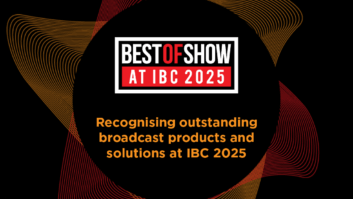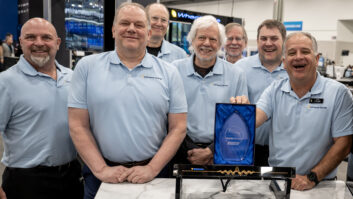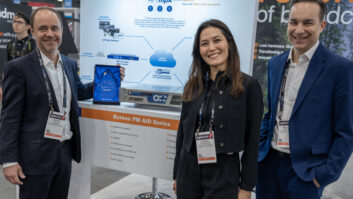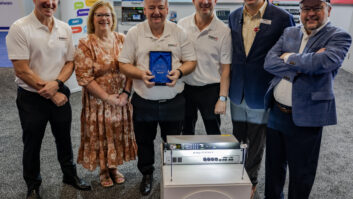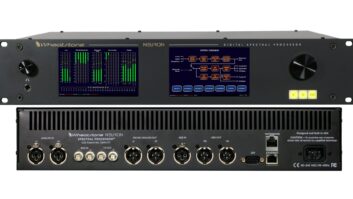(click thumbnail)TASCAM HD-P2For more than 20 years, the venerable cassette recorder was found in the field bag of every reporter assigned to get interviews and cover breaking news events. Unlike its reel-to-reel predecessor, it was relatively small, fairly simple to work with and could be relied upon for at least an hour or two of portable recording capability.
As the PC world spurned development in hard drives and RAM, manufacturers looked at the potential of using new media for audio storage and the demise of the cassette recorder seemed inevitable. New generations of small solid-state flash recorders offer a plethora of audio quality choices (quality in trade for storage capability) and other enhancements that are to the liking of ENG crews.
The long goodbye
In looking around at current offerings, the most obvious question was, what has become of the cassette recorder?
Manufacturers of tape recorders like Marantz and Sony were not late to the table in developing recorders without moving parts, slowly phasing out the cassette medium. Although the cassette has not quite yet been relegated to the land of the cart machine (seeing that Marantz still offers up the PMD222, for instance), very few machines are sold today.
(click thumbnail)Marantz PMD670Bob Cauthen of SCMS told me he discourages buyers from investing in cassette. With improvements in battery capacity over the last few years, along with the ability of newer-generation recorders to benefit from memory upgrades, he says, “Flash is the best.”
Jeff Hugabone of CBS Radio in Hartford, Conn., says as far as his news staff is concerned, “tape is dead.”
“All it took was one demo unit to come in to blow the news staff away. They were hooked from the first 10 minutes that they played with the thing,” he said. His stations’ cassette recorders are now assigned to the lower desk drawers as backup.
Recording audio from a live event is one thing; getting it edited and ready for broadcast is another. The cassette tape was always limited in that it either required that the sound was dumped to another machine, such as a reel recorder or digital workstation in real time, and then manipulated.
With today’s flash recorders, audio can be uploaded to a workstation in much shorter time, allowing for sound bites, for example, to be recorded and edited (in a laptop or even in the device itself) for quick replay during a live broadcast, or for almost instant retrieval. Uploads can be accomplished via USB, Firewire or AES, depending on the recorder.
Versatility, speed and quality are three qualifications being met aggressively by today’s recorders.
Sampling the marketplace
Depending on your needs for format, number of channels, storage capacity and physical size and weight, recorders can range anywhere from a couple of hundred dollars to several thousand.
Most allow for a variety of word size and sample rates (the most common being 24 bit/96 kHz), so that intricate dance of sound quality and amount of recording time can be finessed to fit the task at hand.
Voice recordings can be accommodated with a mono setting, perhaps utilizing a slower clock rate and 16-bit word length for extended recording time, whereas high-quality music recordings are accomplished in stereo with 24-bit word length/96 kHz sample rate. Some recorders, such as the TASCAM HD-P2 (around $1,300) offer sample rates up to 192 kHz.
(click thumbnail)Zaxcom ZFR800The TASCAM HD-P2 also features high quality formats (16 or 24 bit/44.1 to 192 kHz) in a more conventional presentation. Resembling a portable DAT machine, the HD-P2 includes SMPTE time code for sync purposes, a simple user interface and angled LCD screen. Real pots ease control of the input level tactile event.
High-end offerings, such as the Sony PCM-D1 (about $1,900) can do just about anything except run the bath water. It features built-in stereo mics, metering, a wide frequency response (a 30 kHz audio bandwidth using the 24 bit/96 kHz mode), an assortment of selectable recording format options and 4 GB of internal flash.
The flagship of the flash recorders at the time of this writing appears to be the Marantz PMD660, which retails for about $500. This unit sports a four-hour record time, MP2, MP3, WAV (two hours at 48 kbps) and BWF formats, XLR inputs with phantom power (for condenser microphones), a built-in stereo mic and Marantz’s Virtual Track Mode, which allows playback between customized marked points. The palm-sized PMD660 is constructed ruggedly for extensive field use.
In the mid price range of around $700 we find professional machines featuring the state-of-the-art whistles and yet would make anyone familiar with a DAT machine feel at home. The Marantz PMD670 features XLR input/outputs, records at 16-bit WAV, as well as MP3, MP2 and BWF. The seven-hour battery life is a real plus for those on the road.
The company also recently released the CDR310 portable field recorder, which has a hard drive and records 16-bit audio in CD-DA, WAV, AIFF or MP3 formats and then burns a CD.
Mics that record, and more
There are quite a few more interesting tools on the market.
The Roland CD2 CompactFlash and CD recorder might be of interest, if direct-to-CD recording is what you need. Six hours of CompactFlash make this a good choice for archiving longer-term events such as performances and speeches. It also features rugged XLR inputs and outputs, as well as a built-in stereo mic.
AEQ offers the PAW-120 with 512 MB of flash memory. It uses USB connectivity to transfer files to a desktop environment, is compatible with Mac and PC computers and records linear PCM and compressed MPEG.
Olympus debuted its DS-Series, which includes three models that can be used to capture audio or listen to podcasts. Software included with each model eases downloading of audio content from a Web site. Memory from 256 MB to 1 GB enables recording times ranging up to 275 hours.
The Zoom H4 from Samson Technologies features two electret condenser mics configured in an X/Y pattern for stereo recording. Additionally it has onboard studio effects such as compression, limiting and mic modeling.
HHB’s FlashMic DRM85 (and recent cardioid version, DRM85-C) is a digital recording microphone that records WAV or MPEG1 Layer 2 encoded audio files, which can then be transferred to digital workstations via USB cable. It uses a Sennheiser omnidirectional condenser capsule that sends the audio to a 1 GB flash drive.
Zaxcom is now shipping a product in that niche, the ZFR800 digital recording mic, which records up to eight hours of uncompressed audio on a removable 2 GB memory card.
With the introduction of the Sony MZ-M100 (and recently the MZ-M200), Sony improved greatly on the MiniDisc. Less expensive than many of the pro flash recorders at $300, the MZ-M100 utilizes the new Hi-MD disk that can hold one gig of data (it can be used as an external hard drive) or several hours of audio depending on the format utilized (it supports WAV, MP3, ATRAC3, ATRAC3plus and linear PCM).
According to Gary Beebe at BSW, for those that have used the standard MD format in the past, the MZ-M100 will work with the old format discs (however, uploading to your PC with the old disks does not work, unfortunately). The USB interface to a PC results in quick upload times for editing. The new Hi-MD discs also retail for less than $10 each, so storage is inexpensive.
Beebe goes on to say the ability to record in higher quality formats (such as ATRAC3), as opposed to recording in MP3 alone, allows for a better sonic quality to start with in editing. The HHB MDP500 (around $1,700) is another MiniDisc recorder featuring a professional package with XLR connectors, RCA line outputs, USB, optical and S/PDIF input/output.
Developments in CompactFlash battery capacity are in rapid evolution, so the chances are good that the recorder you buy today will have enhanced capability tomorrow.
How does your radio operation record field audio? Tell us at [email protected].





